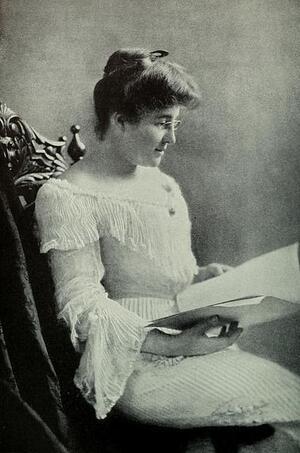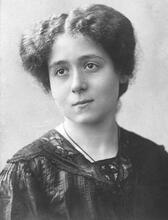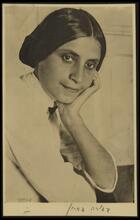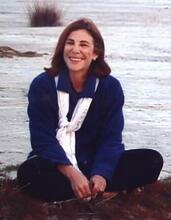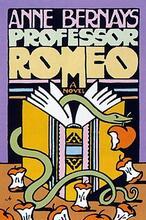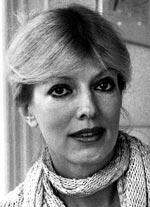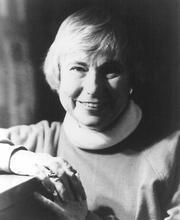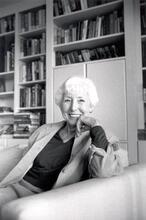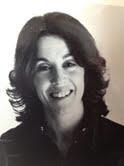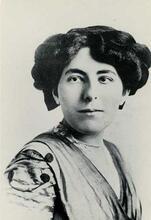Miriam Michelson
Miriam Michelson.
Photograph by George Habenicht, courtesy of Wikimedia Commons
Miriam Michelson grew up in the iconic mining town of Virginia City, Nevada, the seventh of eight children of Jewish immigrant parents. In her twenties, she began contributing articles, features, and criticism to San Francisco newspapers. Her boldness and vivid writing style brought her popularity, and she covered a range of subjects, with particular focuses on women, immigrants, and social justice issues. Michelson also wrote short stories and novels. In the Bishop’s Carriage, her first novel, became a sensation. In her person and her writing, she originated the character of spunky girl reporter, and she became a role model for future women journalists. During her lifetime Michelson was often identified as a famous author, and she also had famous siblings.
Miriam Michelson began her writing career as a journalist, “interviewing a murderer one week and Paderewski the next” and “writing dramatic criticism of a very fearless and truth-telling sort,” according to a 1904 biographical note in Current Literature. When she turned to fiction, her prose kept the lively immediacy, the breezy freshness, of someone capturing the present moment, and her novels became popular reading. A wry awareness of the complications faced by single working women runs throughout Michelson’s writing.
At the turn of the 20th century, Michelson earned a reputation as a wide-ranging journalist, champion of women’s perspectives, popular novelist, and chronicler of the American West. The qualities that made her writing appeal strongly in her own time contributed to later critics dismissing her work as frivolous, but 21st-century reevaluations of Michelson are bringing new attention to the diversity and significance of her extensive output.
Background & Family
Michelson was the youngest of seven children of Samuel and Rosalie (Przylubska) Michelson. The Michelsons immigrated to the United States from Poland in the mid-1850s. After a brief stay in New York, they made the journey to Gold Rush country in California. Eventually they settled in the boomtown of Virginia City, Nevada. Michelson’s second novel, The Madigans (1904), draws on her youth in Virginia City, presenting the adventurous antics of a family of well-read and unruly children, though these children are six sisters.
The Michelson children were definitely standouts. The eldest son, physicist Albert A. Michelson, became the first United States citizen to win a Nobel Prize for science, and the youngest son, Charles Michelson, also a journalist, became a close assistant to Franklin D. Roosevelt. The four Michelson sisters were close. Julia, Pauline, and Bessie, like Miriam, led lives that were independent and unconventional. Julia, who did not marry, taught school. Pauline, also a schoolteacher, married, divorced, and took back her original surname. Bessie married reporter and editor Arthur McEwen, an early mentor of Miriam’s, and she and her husband moved to New York.
Girl Reporter & Famous Author
Beginning in 1895, Michelson contributed special features and drama criticism to San Francisco and Philadelphia newspapers. Her voice was distinctively personal, lively, and always engaging; she was willing to travel to get a story, and she did not shy away from expressing her own opinions. In 1897 she visited Hawaii and reported on Hawaiian protests against United States annexation (San Francisco Call). With equal forthrightness, in a 1901 interview with anarchist Emma Goldman, Michelson focused on Goldman’s humanity and supported the right to free speech (Philadelphia North American).
Along with her articles, Michelson published short stories that became the basis of several of her novels. Her first, In the Bishop’s Carriage (1904), became a sensation. Nancy Olden, the narrator, is a quick-witted young woman who turns to crime after a tough childhood as an orphan. She succeeds in reforming herself and becoming a successful actor, while retaining her sassy charm. The book was a bestseller and two movies were based on it. In the Bishop’s Carriage, starring Mary Pickford, appeared in 1913, and She Couldn’t Help It, starring Bebe Daniels, in 1920. A later novel, Michael Thwaite’s Wife (1909), was also the basis for a movie, retitled The Better Half (1918).
Michelson was one of the first journalists to both embody and popularize the role of “girl reporter.” In her third novel, A Yellow Journalist (1905), the main character, Rhoda Massey, is a smart-talking, hard-working female reporter, much like Michelson herself. The novel that followed, Anthony Overman (1906), focuses on the romance between another spunky but cynical female reporter and a pure-minded reformer. Characters such as these became role models for women interested in journalism, including Edna Ferber. Ferber wrote in her autobiography, Peculiar Treasure, that Michelson’s A Yellow Journalist stories were “fresh and racy … all about a woman reporter and her dashing adventures on a big-town paper. There was the kind of newspaper woman I wanted to be” (p. 153).
Social Justice Advocate & Suffragist
Michelson’s subjects, in both her journalism and her fiction, were diverse. Her fiction included Native American characters as well as immigrants from Ireland and China. There were also Jewish characters in her work, such as a grandmother who makes an impression on Rhoda Massey in A Yellow Journalist, and Michelson was frequently described as a Jewish American writer. Her family was not religious, however, and Michelson did not strongly identify as Jewish (Milliken, 128-9).
Portraying the lives of women, both the ordinary and the extraordinary, was a constant hallmark of Michelson’s work. She profiled prominent suffrage advocates, such as Susan B. Anthony and Charlotte Perkins Gilman, covered suffrage movement events, advocated for gender equality, and joined organizations that supported suffrage. Her novella The Superwoman, which appeared in 1912, one year after California granted women the right to vote, depicted a utopian society ruled by women.
Michelson’s last published book was a history of her childhood home, Virginia City, entitled The Wonderlode of Silver and Gold (1934). As described in the New York Times Book Review of June 17, 1934, she, once again, wrote “with insight and understanding ... with a mocking humor ... [and a] crisp levelheadedness.”
Fiction and Memoir
Anthony Overman (1906)
*The Awakening of Zojas (1910)
*In the Bishop’s Carriage (1904)
*The Madigans (1904)
*Michael Thwaites’s Wife (1909)
Petticoat King (1929)
†*The Superwoman (in The Smart Set, Vol. 37, No. 4)
The Wonderlode of Silver and Gold (1934)
*A Yellow Journalist (1905)
Articles and Features (a sampling of the hundreds written by Michelson)
†”The Real New Woman: Miriam Michelson Likens Her to a Pleasant Dream, Not a Nightmare,” San Francisco Call, May 26, 1895, 8.
†“Strangling Hands Upon a Nation’s Throat. Many Thousands of Native Hawaiians Sign a Protest to the United States Government Against Annexation,” San Francisco Call, September 30, 1897, 1-3. https://hawaiiankingdom.org/pdf/San_Francisco_Call_(1897).pdf (retrieved July 29, 2019)
†“A Character Study of Emma Goldman,” Philadelphia North American, April 11, 1901. 2.
†“Destruction of San Francisco,” Harper’s Weekly 50, no. 2575 (May 5, 1906): 623-624
*EBook available free on Google Books
†Included in whole or in part in The Superwoman and Other Writings by Miriam Michelson
Alexander Street. Online Biographical Dictionary of the Woman Suffrage Movement in the United States (OBD). https://documents.alexanderstreet.com/VOTESforWOMEN (accessed July 29, 2019).
Campbell, Donna M. Bitter Tastes: Literary Naturalism and Early Cinema in American Women's Writing. Athens: University of Georgia Press, 2016.
Harrison-Kahan, Lori. The Superwoman and Other Writings by Miriam Michelson. Detroit: Wayne State University Press, 2019.
Harrison-Kahan, Lori and Karen E. H. Skinazi. "Miriam Michelson's Yellow Journalism and the Multi-Ethnic West." MELUS: Multi-Ethnic Literature of the United States 40, no. 2 (2015): 182-207.
Harrison-Kahan, Lori, and Karen E. H. Skinazi. “The Girl Reporter in Fact and Fiction: Miriam Michelson's New Women and Periodical Culture in the Progressive Era.” Legacy, 58, no. 2 (2017): 321-338.
Harrison-Kahan, Lori, and Karen E. H. Skinazi, “Miriam Michelson.” In Writers on Women’s Rights and United States Suffrage, edited by George Parker Anderson. Biography, v. 381. Farmington Hills, Mich: Gale, a Cengage Company, 2018.
Lelekis, Debbie. American Literature, Lynching, and the Spectator in the Crowd: Spectacular Violence. Lanham, Maryland: Lexington Books, 2015.
Livingston, Dorothy Michelson. The Master of Light; a Biography of Albert A. Michelson. New York: Scribner, 1973.
Lutes, Jean Marie. Front Page Girls: Women Journalists in American Culture and Fiction, 1880-1930. Ithaca, N.Y.: Cornell University Press, 2006.
Michelson, Charles. The Ghost Talks. New York: G.P. Putnam's Sons, 1944.
Millikan, Robert Andrews. Biographical Memoir of Albert Abraham Michelson, 1852-1931. 1938.
Skinazi, Karen E. H. and Lori Harrison-Kahan. “Miriam Michelson, American Jewish Feminist Literary Star of the Western Frontier.” Tablet, November 24, 2014. https://www.tabletmag.com/jewish-arts-and-culture/books/187115/miriam-michelson

